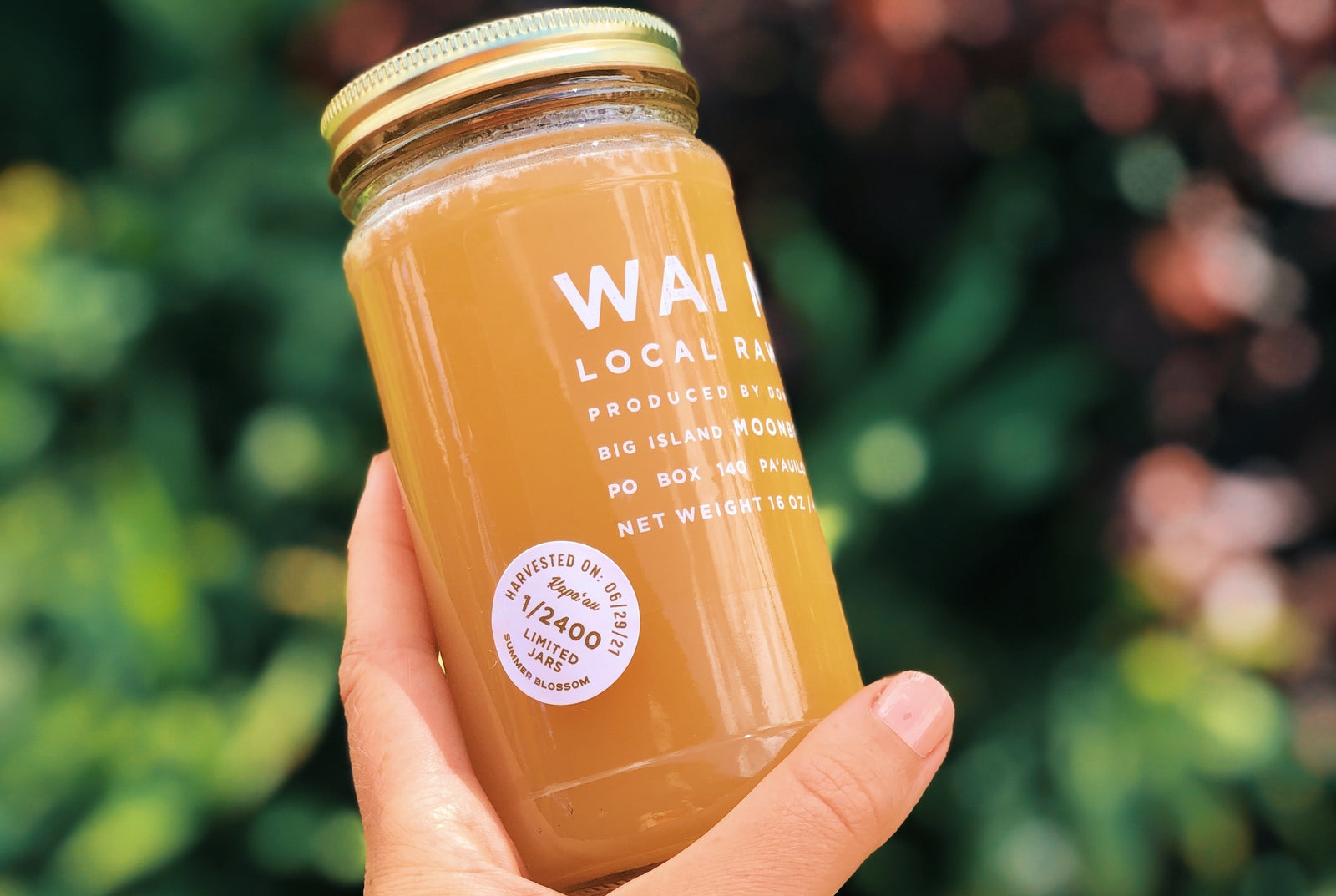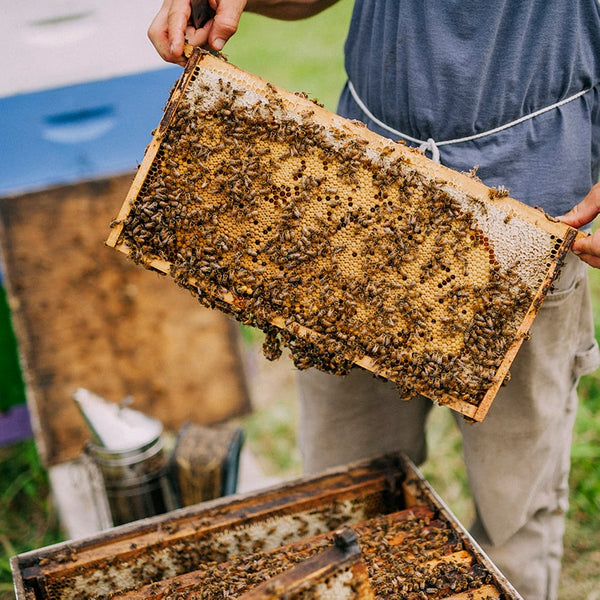
What Makes a Honey Varietal
March 22, 2022 5 min read
An exploration of the floral sources and blooms of Hawaii Island + Wai Meli Honey
When most people walk up to our farmer’s market booth they’ve never heard of different varietals of honey. We’re often asked which of our honeys is ‘regular’ honey, to which we smile and introduce the concept of varietals. Much like wine, honey comes with many tastes, textures, flavor notes, and nuances all depending on one thing - the varietal. The varietal is a fancy way to say ‘nectar source,’ or the floral bloom from which the bees feed to create a particular honey. You might be familiar with clover honey, or wildflower honey. For both of these the honey is a result of the bees feeding on clover blossoms and wildflower blossoms, respectively. They then bring that nectar back to the hive, mix it with numerous enzymes and beneficial bacteria, and stuff it into the cells in their hive. From there, they fan the mixture to evaporate water and decrease the water content, which would lead to spoilage over time. When the nectar mixture is ready, honeybees then cap the cell with beeswax, storing the honey for later use.
The process of making honey remains the same - collect nectar, mix it with enzymes and bacteria from the honeybees’ gut, stuff it into hexagonal cells, fan it to decrease moisture content, and cap the honey to save it for later. The one thing that varies is the nectar itself. The nectar source is dependent on (1) what is currently in bloom and (2) where the bees are located. We choose to place our beehives in specific locations to capture what we believe are the most flavorful, unique, and distinct honeys the island has to offer. We also take into account the length of a bloom so that we can capture a single varietal, as opposed to a multi-floral varietal, which is to say a blend of many nectar sources.
On Hawaii Island specifically, we have access to a wide variety of nectar sources for our bees - from endemic plants to naturalized plants to invasive plants - each producing a distinct honey. Each honey varietal has distinct qualities and characteristics - including taste, texture, color, aroma, and degree of liquidness or crystallization. We offer about seven varietals throughout each year, which shift slightly year to year. Below you’ll find a brief summary of each of the varieties we produce, including flavor notes, description, and the time of year we harvest it. You’ll come to see that honey isn’t just honey and there’s really no such thing as ‘regular’ honey in our world.
Location: South Kohala
Taste Profile: Evenly sweet with hints of powdered sugar, fine delicate crystals
Season: High Summer
Widely prized across the island and beyond, pure Kiawe Blossom honey is a pure crystalline white honey. It is made from the nectar of the mesquite trees that have naturalized on the beaches of the Kona Coast. Evenly sweet with hints of powdered sugar, and fine delicate crystals, it’s a perfect match for toast, strawberries and cream, or as we often say - right by the spoonful.
Location: South Kohala
Taste profile: aroma of honeysuckle, light dewiness on the tongue
Season: Late spring, early summer
Harvested in the late spring and early summer months on the Big Island, this Kiawe Coconut Honey comes in a 16oz jar and is a rare and select favorite.
Before the kiawe bloom is in full swing honeybees supplement their diet with nectar from the coconut palm. This varietal carries the aroma of honeysuckle and offers a light dewiness on the tongue. This raw honey is a team favorite for its unique taste and texture.
Location: Kapa’au
Taste profile: ripe tropical fruits, sweet, bold, pungent
Season: Early Spring
This honey is another varietal unique to the Big Island. Harvested in Spring from our North Kohala bee yards, this honey has the tendency to stay liquid longer than any other honey our hives produce. The Java Plum Blossom honey has a powerful taste profile of ripe tropical fruits such as guava and mango. Its extremely sweet flavor carries the bold and pungent body of exotic honey from the Hawaiian Islands.
Location: Kapa’au
Taste profile: bright notes, well-balanced flavors, a hint of spiciness
Season: Spring and Autumn
Also known as Brazilian Pepper, or Wililaiki in Hawaiian, this non-native tree blossoms each year at a time when few other trees are flowering, making it an important crop for our honeybees. It provides a food source for the bees during this dearth period, and lucky for us, it also makes for a delightful honey! The bright notes and well-balanced flavors in this harvest contain a hint of spiciness. This honey also has a subtle green hue in its meniscus, a reminder of the intense floral source from which it originates.
Location: Pa'auilo Mauka
Taste profile: delicate floral notes and occasional hints of buttered popcorn
Season: Spring and Autumn
Foraged from vibrant blossoms of the Ohi'a, a very special tree endemic to Hawai'i, our bees gather this unique honey in spring and summer from the forests surrounding our farm in Pa'auilo Mauka. This light honey is elegant and sweet with delicate floral notes and occasional hints of buttered popcorn. Our Lehua Blossom honey is lightly crystallized and maintains a delightfully spreadable texture.
Location: Pa'auilo Mauka
Taste profile: butterscotch, creme brûlée, caramelized sugar
Season: Autumn to Early Winter
Eucalyptus Robusta typically blooms September through November, making this honey a seasonal fall harvest on our island. When the nectar is foraged from a single floral source such as this one, the honey has a wonderfully rich brown and amber color, very smooth texture, and an intense flavor, reminiscent of the robust trees from which it is derived. This honey has flavor notes of butterscotch, creme brûlée, or caramelized sugar.
Location: Pa'auilo Mauka
Taste profile: rich, round, deep and robust with hints of maple syrup
Season: Winter
This Macadamia Blossom Blend Honey is from our Pa’auilo bee yard. It is a one-off blend that offers rich, dark, and well-rounded flavors. This varietal is the darkest honey we harvest all year and comes during the winter months.
As the temperatures drop to 60 degrees F in our Macadamia orchard, the trees push out their flower tassels and attract our honey bees to their elegant sprays. This honey offers rich flavors of molasses and a smooth palate that carries hints of the previous trees that were in bloom, the Eucalyptus robusta. This combination is extremely unique and makes a delightful addition to brines, marinades, or simply drizzled atop vanilla ice cream. Our personal favorite is to enjoy this honey by the spoonful.
Stay tuned in to our blog, where we’ll continue to explore each of these varietals in depth and share education about honey, honeybees, beekeeping, and our farm in Hawaii. For ideas on how to utilize each honey in your day to day, visit our recipe blog for simple, healthful recipes to add to your home and hearth.

Stay Connected
Join our mailing list today for exclusive content and specials.

